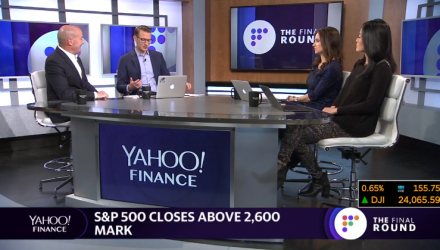Lydon also mentioned that ETFs account for $3.4 trillion of the marketplace while mutual funds comprise $16 trillion, debunking that myth that they create faux liquidity.
The growth of ETFs is a trend that will likely persist, and one that highlights a dichotomy between ETF investors and mutual fund investors. Just as markets were getting roiled in 2018, money continued to flow into ETFs, but what is fueling this divergence?
The answer lies in the inherent benefits of ETFs compared to mutual funds–a confluence of the investment vehicle’s simplicity, liquidity, tax efficiency, a plethora of choices with over 2,000 ETF products, and much more.
“We’re starting to see maybe a behavioral divergence between ETF investors and mutual fund investors who, for many cases, are upset about the low performance and lax of tax efficiency, to some degree have thrown in the towel,” said Lydon.
Out with Growth, In with Quality
With 2018’s year-end sell-offs in U.S. equities, investors are giving value investing another look as growth and momentum might be making their way to the exits. A byproduct of a shift to value is a focus on the quality of investments–being selective and using due diligence as screeners to find the best-performing investments.
“During a late cycle, there are actually factors that do quite well,” said Lydon. “Moving away from pro growth, pro-momentum and into areas like value, quality, dividend-oriented strategies.”
As such, Lydon mentioned investors flocking to funds like the iShares Edge MSCI USA Quality Factor ETF (BATS: QUAL). QUAL seeks to track the investment results of the MSCI USA Sector Neutral Quality Index composed of U.S. large- and mid-capitalization stocks with quality characteristics as identified through certain fundamental metrics.
Wave of Disruption Headed for Markets
A wave of disruption is headed for the markets and whether society wants it or not, robotics, artificial intelligence (AI), machine learning, or any other type of disruptive technology is the next wave of innovation. For investors who missed out on FAANG (Facebook, Amazon, Apple, Netflix, Google) stocks, they can look to capitalize on disruptive tech options in 2019.
To take advantage of this transformative movement, Lydon suggests investors look at the ARK Innovation Fund (NYSEArca: ARKK). ARKK’s focus is primarily on domestic and foreign equity securities of companies that coincide with the ETF’s investment theme of disruptive innovation–a technology or strategy that disrupts the status quo and develops its own niche market. ARKK invests in both developed and emerging markets with the intent to use American Depositary Receipts (ADRs)–securities offered in the U.S., but are offered as a specified number of shares in a foreign corporation.
“If you dig down into the portfolio, you will find that there are areas like genome sequencing, robotics, artificial intelligence, and biotechnology that are really pure plays in that space,” said Lydon. “There are a lot of thematic ETFs that when you open up the hood, you see the different constituents not necessarily specific to that theme. This group, ARK Innovation, does a great job of diving in, cutting up those thematic sectors.”
For more market trends, visit ETF Trends.
